Tiny ox and puppy lead Bonhams Netsuke sale
LONDON.- Building on the outstanding results of its previous sale of Japanese netsuke from the Katchen collection, Bonhams presents The Julius and Arlette Katchen Collection of Fine Netsuke: Part II in London on Wednesday 10 May 2017.
Highlights of the sale include an ox by Izumiya Tomotada estimated at £25,000–30,000 and a puppy by Kaigyokusai Masatsugu estimated at £20,000–30,000.
Among surviving animal carvings by Tomotada—an eighteenth-century master—the Katchen ox, considered to be a unique model, forms a compact and dramatic sculpture finished in fine detail reflecting the influence of contemporary painting. Only 5 cm in width, the ox was once part of the M.T.Hindson collection, which was dispersed in a series of legendary sales half a century ago.
Lot 53. A rare ivory netsuke of a recumbent ox, by Tomotada, Kyoto, 18th century. Estimate: £25,000 - 30,000 (€29,000 - 35,000). Photo: Bonhams.
Signed in a rectangular reserve Tomotada. 5.1cm x 4.5cm (2in x 1¾in).
Provenance: Guest collection, no.1314.
Mrs Isobel Sharpe collection.
M. T. Hindson collection.
Published: The Connoisseur, London, April, 1955.
Davey, MTH, p.67, no.169.
Katchen, N7, vol.1, p.49, no.K237.
Note: Resting with its head raised to the right and its legs drawn in, the slightly worn ivory bearing a good patina and the eyes with inlaid pupils.
The model is believed to be unique and forms a compact and dramatic study. The work shows some affinities with that of Masanao and it was thought by Hindson that it may represent a collaboration between the two carvers.
The Katchen puppy by Masatsugu—an artist active during Japan’s opening-up to global trade in the later nineteenth century—is even smaller than the ox. It was a favourite of Julius Katchen, who paid a record price of £945 for it at an English country auction in 1964.
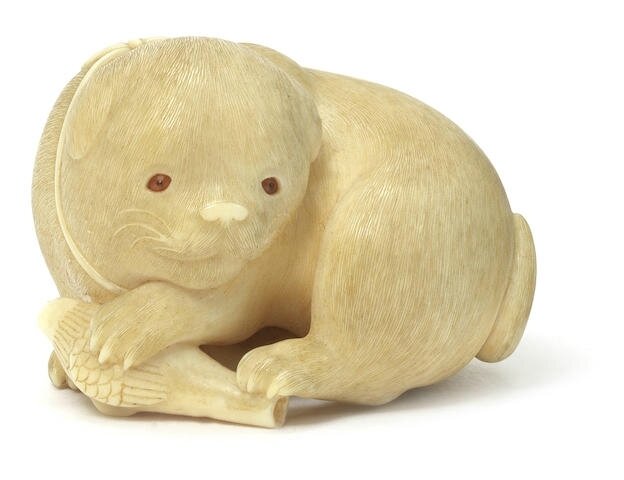
Lot 129. An ivory netsuke of a puppy, by Kaigyokusai Masatsugu (1813-1892), Osaka, mid/late 19th century. Estimate: £20,000 - 30,000 (€24,000 - 35,000). Photo: Bonhams.
Signed in a rectangular reserve Kaigyokusai with seal Masatsugu. 3.8cm (1½n) wide.
Provenance: Purchased at Boons Park, Kent, England, 1964.
Published: Katchen, N7, vol.1, p.123, no.K63.
Note: Lying with its head turned to the left and its left paws resting on a bird whistle, one leg forming the himotoshi, a knotted collar around its neck, with one long cord trailing over the back and beneath, the ivory unstained and the eyes inlaid in amber.
Similar examples are illustrated in Davey, MTH, p.53, no.126 and Lazarnick, NIA, vol.1, p.563.
In 1964, Julius Katchen surprised netsuke aficionados, including Geoffrey Moss, who was bidding for him, as well as the underbidder, Douglas Wright, by paying the record price £945 for this netsuke in a small country sale, a record which stood unchallenged for five years.
Whenever possible and wherever they were, Katchen—one of the finest pianists of his generation—and his wife Arlette visited dealers and auction rooms in between performances at most of the world’s greatest concert halls, amassing a collection which Bonhams has been appointed to offer for sale in three parts. The 200 lots in Part II include several other masterpieces, among them a carving of a stag estimated at £50,000–70,000.
Lot 141. A large ivory netsuke of a stag, After Tomotada, Kyoto, 19th century. Estimate: £50,000 - 70,000 (€59,000 - 83,000). Photo: Bonhams.
Inscribed in a rectangular reserve Tomotada. 10.5cm (4 1/8in) high..
Provenance: Purchased at Hauswedell, Hamburg, 1962.
Published: Anne Hull Grundy, 'Tomotada and Okatomo, in Relation to the Kyoto School of Netsuke Carvers' in The Antique Collector, Part I, June 1963, p.107, fig.1.
Katchen, N7, vol.1, p.77, no.K375.
Note: Seated, its head raised and with open mouth as it bays to the sky, its antlers pressed back and its legs drawn in, the slightly worn ivory with a good patina and the pupils inlaid.
For smaller versions of the subject by Okatomo, see Bandini, SON, p.118, no.172; and Earle, NFR, p.260, no.226.
Netsuke, first used in Japan in the seventeenth century, served both an ornamental and a practical purpose. Since traditional Japanese clothes had no pockets, netsuke were tied to the top end of cords, hanging from the wearer’s sash, from which a variety of pouches and containers would hang. Over time, they came to be elaborately carved and are prized today as the most beguiling sculptural works of the early modern period.
Suzannah Yip, Bonhams Head of Japanese Art said, “Netsuke have long been collected by people who appreciate Japanese skill and creativity and we are delighted to offer yet more wonderful and varied examples. Building on the outstanding success of our Part I sale last November which achieved the second-highest price ever paid at auction for a netsuke—£221,000 for another carving of a dog—we hope to set a new benchmark for this important segment of the global market for East Asian art."

/https%3A%2F%2Fprofilepics.canalblog.com%2Fprofilepics%2F1%2F0%2F100183.jpg)
/https%3A%2F%2Fstorage.canalblog.com%2F03%2F02%2F119589%2F96711876_o.jpg)
/https%3A%2F%2Fstorage.canalblog.com%2F11%2F31%2F119589%2F94773502_o.jpg)
/https%3A%2F%2Fstorage.canalblog.com%2F20%2F83%2F119589%2F94772815_o.jpg)
/https%3A%2F%2Fstorage.canalblog.com%2F26%2F72%2F119589%2F75604929_o.jpg)
/https%3A%2F%2Fstorage.canalblog.com%2F59%2F60%2F119589%2F26458628_o.jpg)
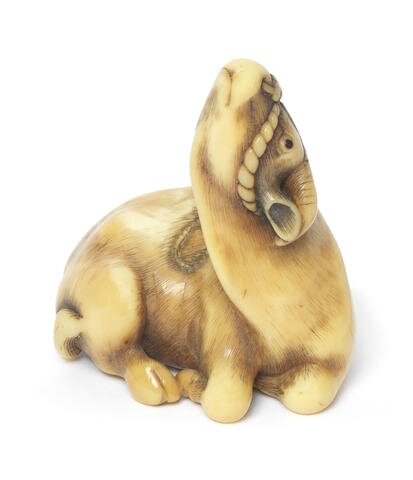

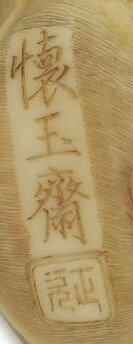
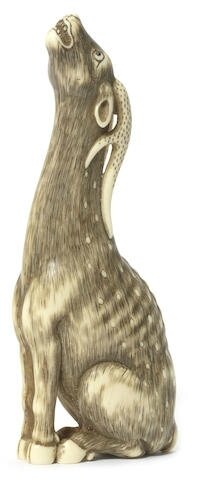
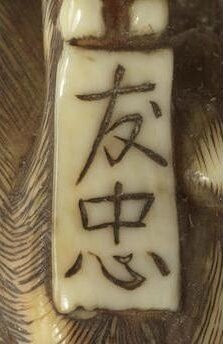


/http%3A%2F%2Fstorage.canalblog.com%2F00%2F00%2F119589%2F129758935_o.jpg)
/http%3A%2F%2Fstorage.canalblog.com%2F29%2F28%2F119589%2F129637299_o.jpg)
/http%3A%2F%2Fstorage.canalblog.com%2F88%2F37%2F119589%2F129631480_o.jpg)
/http%3A%2F%2Fstorage.canalblog.com%2F77%2F79%2F119589%2F129631259_o.jpg)